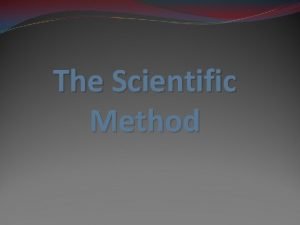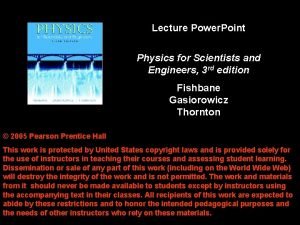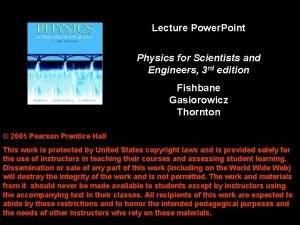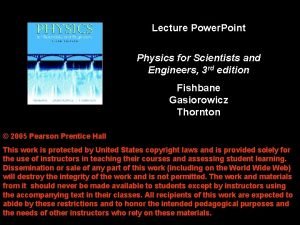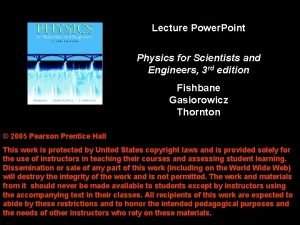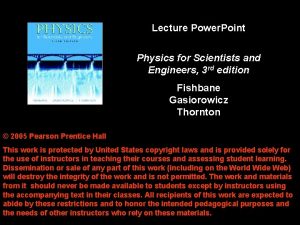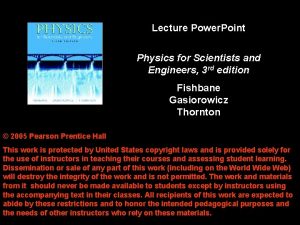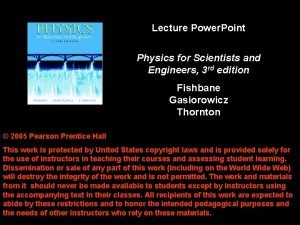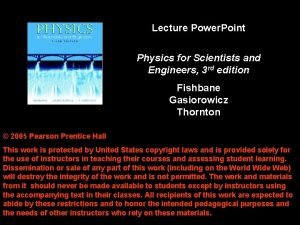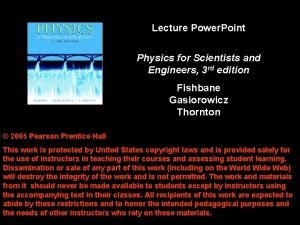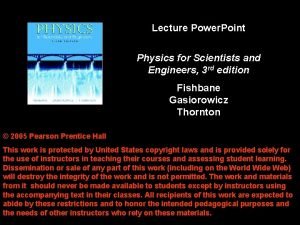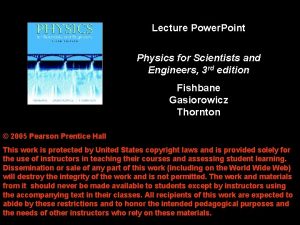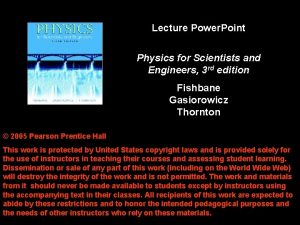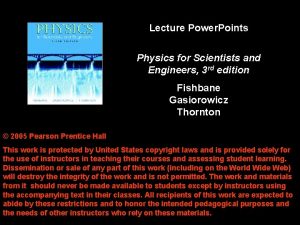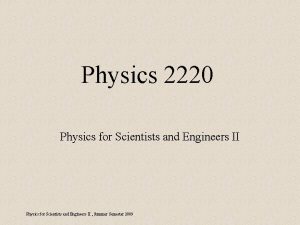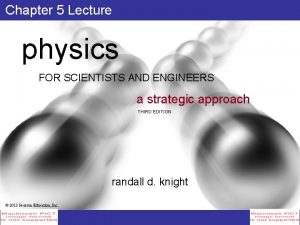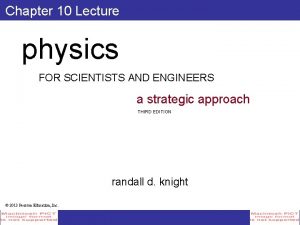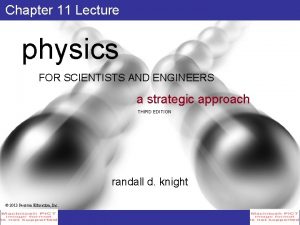Lecture Power Point Physics for Scientists and Engineers




















- Slides: 20

Lecture Power. Point Physics for Scientists and Engineers, 3 rd edition Fishbane Gasiorowicz Thornton © 2005 Pearson Prentice Hall This work is protected by United States copyright laws and is provided solely for the use of instructors in teaching their courses and assessing student learning. Dissemination or sale of any part of this work (including on the World Wide Web) will destroy the integrity of the work and is not permitted. The work and materials from it should never be made available to students except by instructors using the accompanying text in their classes. All recipients of this work are expected to abide by these restrictions and to honor the intended pedagogical purposes and the needs of other instructors who rely on these materials.

Chapter 14 Waves

Types of Waves: Transverse

Types of Waves: Longitudinal

The Wave Equation (14 -10)

Periodic Waves (14 -18) (14 -17) (14 -20)

Traveling Waves: Transverse Waves (14 -22)

Traveling Waves: Longitudinal Waves (14 -27) (14 -28)

How the Wave Speed Depends on the Medium (14 -29) The Speed of Sound in Air (14 -31) Shear Waves in Solids (14 -32)

Energy and Power in Waves The Power Delivered by Waves (14 -35) For a harmonic traveling wave: (14 -36) (14 -37)

Standing Waves (14 -39) (14 -41)

Standing Waves The Frequencies of Standing Waves (14 -43 a) 1. For a particular string, the standing waves with smaller wavelengths also have smaller oscillation periods. 2. For a given wavelength and string length, a less dense string vibrates more rapidly than a denser one. 3. For a given wavelength and string length, a string under more tension vibrates more rapidly than a string under less tension.

Standing Waves Harmonics (14 -44 a) (14 -44 b) (14 -44 c)

More about Sound The Nature of Sound Waves (14 -45)

More about Sound Standing Sound Waves

More about Sound Standing Sound Waves

More about Sound Hearing Sounds

The Doppler Effect Moving Source (14 -49)

The Doppler Effect Moving Observer (14 -53)

Shock Waves (14 -59)
 01:640:244 lecture notes - lecture 15: plat, idah, farad
01:640:244 lecture notes - lecture 15: plat, idah, farad Power triangle formula
Power triangle formula Power bi training powerpoint
Power bi training powerpoint Point point power
Point point power Power system dynamics and stability lecture notes
Power system dynamics and stability lecture notes Power system dynamics and stability lecture notes
Power system dynamics and stability lecture notes Physics 111 lecture notes
Physics 111 lecture notes Physics 101 lecture
Physics 101 lecture Phy101 lecture 1
Phy101 lecture 1 Physics 101 lecture notes pdf
Physics 101 lecture notes pdf Waves physics pdf notes
Waves physics pdf notes Atmospheric physics lecture notes
Atmospheric physics lecture notes Power system analysis lecture notes
Power system analysis lecture notes Power semiconductor devices lecture notes
Power semiconductor devices lecture notes Switch mode power supply lecture notes
Switch mode power supply lecture notes Things fall apart traditions and customs
Things fall apart traditions and customs Hub-and-spoke system pros and cons
Hub-and-spoke system pros and cons Sometimes scientists make a mistake or
Sometimes scientists make a mistake or Diagrams tables and graphs are used by scientists mainly to
Diagrams tables and graphs are used by scientists mainly to Modern physics vs classical physics
Modern physics vs classical physics University physics with modern physics fifteenth edition
University physics with modern physics fifteenth edition


















